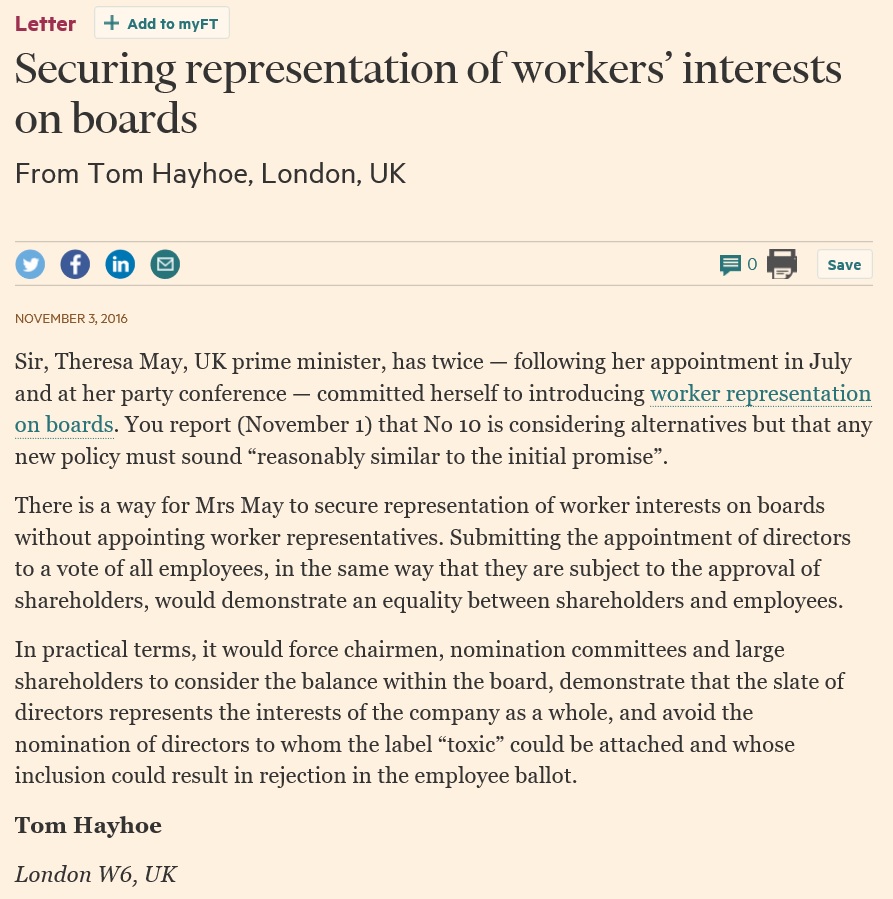Milton Friedman got a name check twice in today’s FT, on the letter’s page and in an article by Philip Delves Broughton on the facing comment page. What was it that Keynes said about defunct economists?*
The first reference was in a letter from Philip G Cerny, Professor Emeritus of Politics and Global Affairs, University of Manchester and Rutgers University, writing in response to Jo Iwasaki who was calling for moral leadership to prevent behaviour like that revealed in the VW Dieselgate:
“The first mandatory prerequisite for company executives is maximum profitability, whether for the company as a whole or shareholders in particular, as Milton Friedman and others have so successfully argued. Culture comes a long way behind, and only comes into play if it actually contributes to profitability. In other words, there is an inherent structural conflict between profitability and the kind of moralistic behaviour Ms Iwasaki wishes to prescribe.
“On the contrary, there is in fact a deep culture of profitability that prevents other sorts of cultural values from working. Only factors outside the company — whether government regulations, the courts, consumer rebellion, strong public interest pressure groups or exposure to scandal (as with Dieselgate) — can be effective, and only then if they do not seriously dent profitability. That’s capitalism.”
The shortcoming in the Friedman perspective on which Cerny relies is the failure to understand that the primary driver for the company executive is self interest, rather than corporate profitability. Corporate profitability is a driver of behaviour only to the extent that it affects self interest. Self interest is a function of lifestyle preferences, reputation enhancement, job security, bonus targets and personal moral compass. The challenge facing boards and investors, and indeed all those with an interest in how the company behaves, is how to align the interests of executives with their own.
The second reference to Milton Friedman is more insightful and comes in Philip Delves Broughton’s column, which is titled “American business is the master, not victim, of globalisation: If businesses saw more value in investing in US workers, they could have done so”.
Delves Broughton addresses the prospects for bring offshored jobs back to the United States, as promised by Donald Trump. Referring to Steve Jobs telling Barak Obama in 2011 that the jobs manufacturing iPhones wouldn’t be coming to the US anytime soon, he notes that manufacturing jobs are increasingly disappearing as automation takes over, and that Shenzen is way down the learning curve and now delivers quality that Apple would struggle to find in the US. However, the principle point of the article is that
“….the best US companies had become brilliant at managing across borders and directing resources to where they generate the highest returns. They weren’t victims of globalisation. They were its masters and had become less and less American.”
Delves Broughton continues later in the article:
“If one accepts Milton Friedman’s argument that a corporation’s sole responsibility is to its owners, then one cannot find fault with these multinationals. They plant their flag where the money is. Their shareholders don’t want them playing the “Star Spangled Banner” in the boardroom. And while they may not directly be investing in American workers, they are generating returns for US investors who can reallocate their capital as they see fit. Mr Trump has done precisely this with his own business, investing in property deals far beyond US shores.
“But this is a fragile argument and Mr Trump is gleefully smashing it to pieces. He knows you cannot respond to stagnant wages and economic insecurity among the working and middle classes with the crystalline logic of a Nobel-winning economist. And he is threatening to perp walk before the press any companies that disappoint him.”
Offshoring in order to harness skills and low cost labour has probably generated greater benefits overall for the US population as a whole, as a consequence of lower prices, higher quality and, for that matter, returns to shareholders. But Delves Broughton is right to challenge the shareholder value orthodoxy that is an expression of the Milton Friedman view of the world. One of the consequences of this way of looking at, and describing capitalism has been the increasing inequality in US society that has fuelled American populism and landed the US, to say nothing of the wider world, with President Trump.
We can only hope that the resilience of American society and politics can withstand four years of a Trump presidency. US companies face a challenging time, notwithstanding the appointment of representatives of large corporations to cabinet posts and promises of tax breaks, as the government tries to deliver on its promises to the rust belt. One way of understanding their plight is to reflect on an excessive focus on the “crystalline logic of a Nobel-winning economist” (while, at the same time, being complicit in the way that top managers were being rewarded by boards composed of their peers at everyone else’s expense) and not paying sufficient attention to the wider constituencies, particularly employees, suppliers and the political world.
*”The ideas of economists and political philosophers, both when they are right and when they are wrong, are more powerful than is commonly understood. Indeed the world is ruled by little else. Practical men, who believe themselves to be quite exempt from any intellectual influence, are usually the slaves of some defunct economist.” The General Theory of Employment, Interest and Money (1936), Ch. 24 “Concluding Notes” p. 383-384

